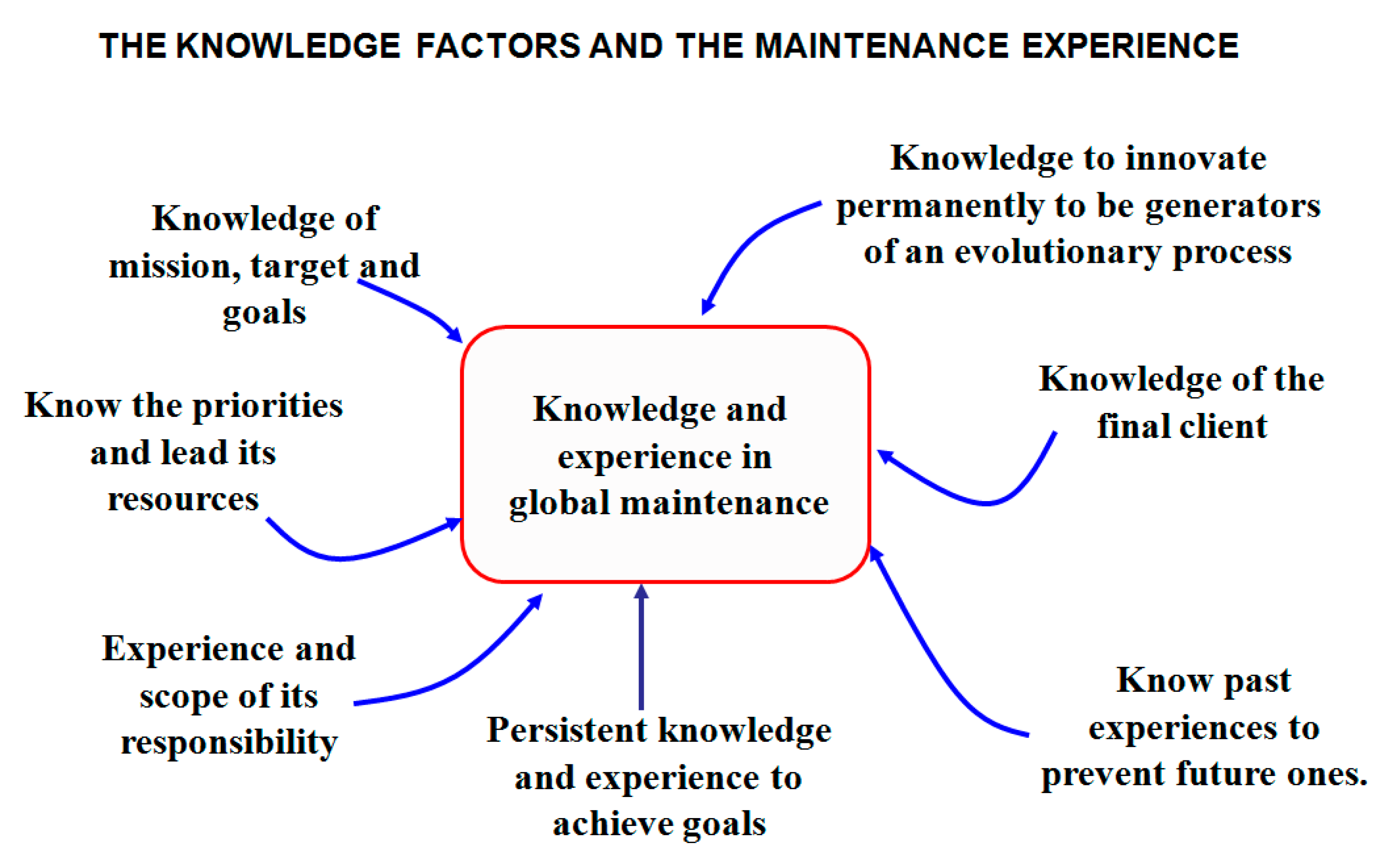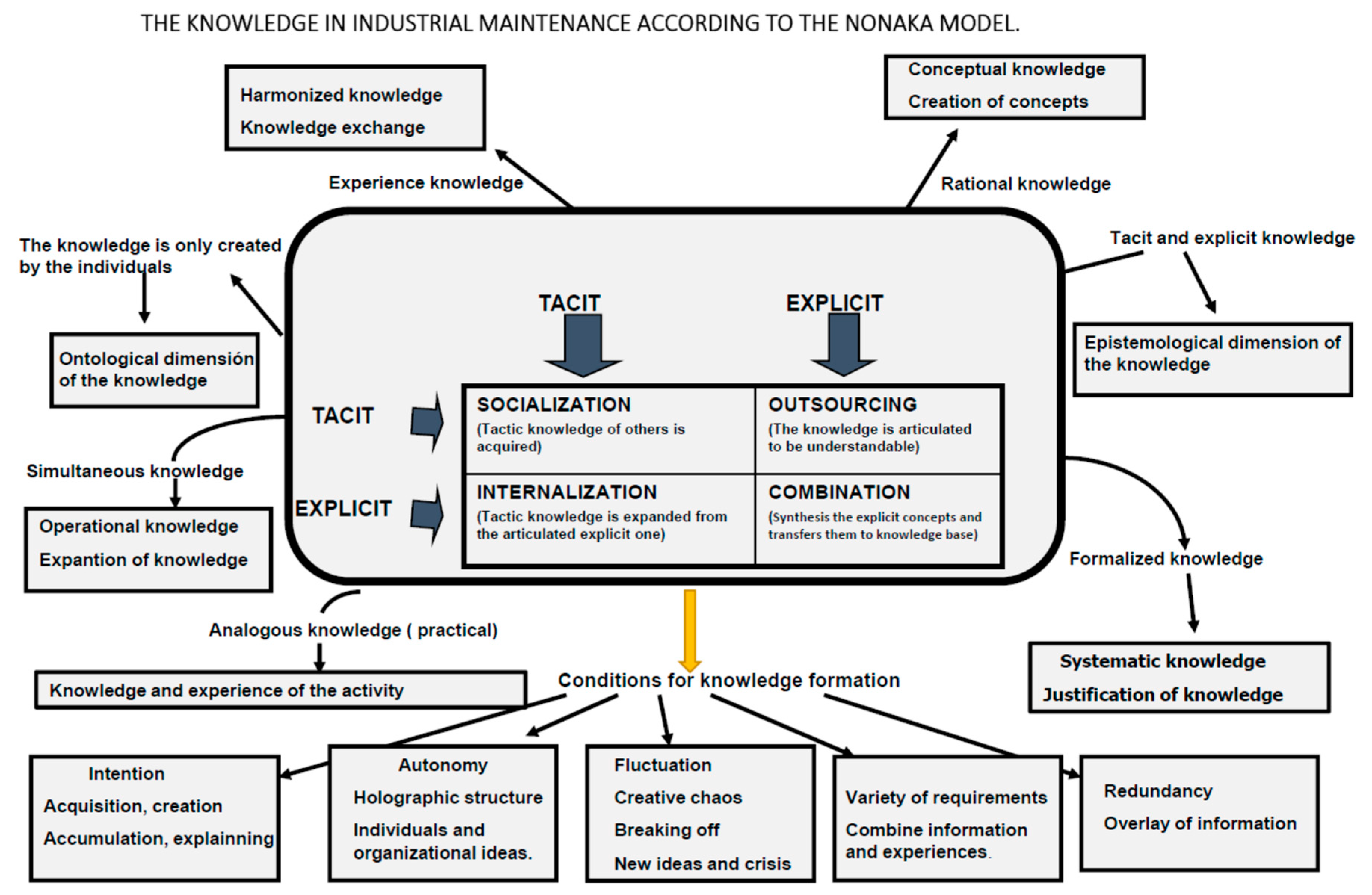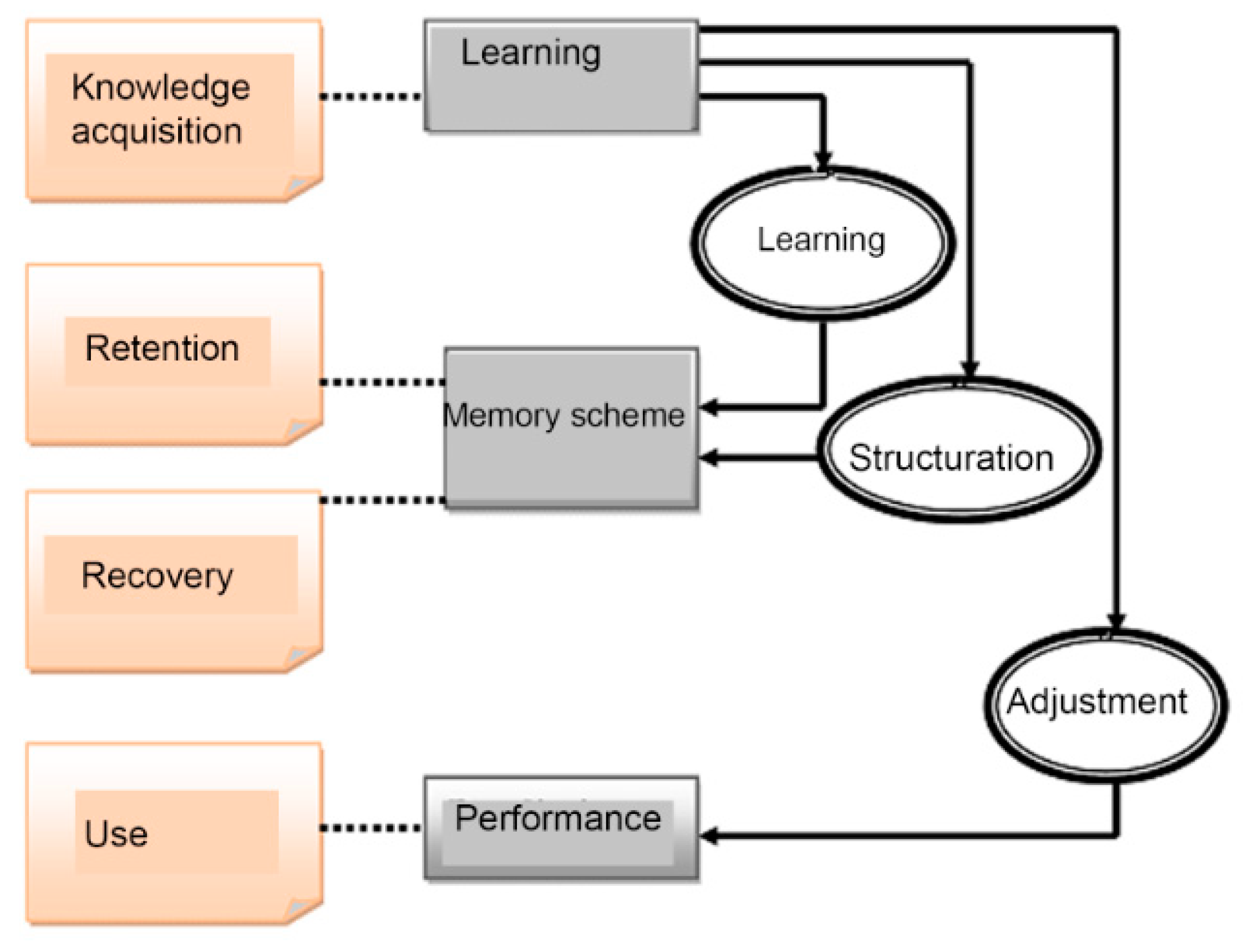Factors in the Relationship between Maintenance Engineering and Knowledge Management
Abstract
1. Introduction
2. Materials and Methods
- 1.
- Is there any knowledge management policy within the company? And within the maintenance activities?
- 2.
- In daily activities related to your duty, how do you create the knowledge that is normally used in your duty?
- 3.
- How is the coding and storage of the generated knowledge produced? How do you contribute to it? and the rest of coworkers?
- 4.
- How does the personal knowledge is transmitted? To what extent does the level of tacit knowledge affect the resolution of failures or unscheduled stops in these technical structures?
- 5.
- How do you use stored knowledge and how does it impact the company?
- 6.
- What barriers exist within the maintenance activities so the proper knowledge management can be achieved?
- 7.
- What would improve knowledge management in your work? What do you think you could do to improve it or the company?
- 8.
- What is the involvment of your senior regarding knowledge management?
- 9.
- Have any audits taken place? Have knowledge maps been created or used to clarify knowledge flows within the most important tactical activities?
3. Results
- ▪
- Acquisition of external and internal knowledge: both internal and external activities support the organizational process and provides new maintenance knowledge.
- ▪
- Important elements of knowledge generation: individual and organizational actions support or restrict the knowledge generation.
- ▪
- Transfer of knowledge through informal or formal mechanisms: the formal mechanisms codify or store the knowledge through the data base, documents or computer tools which are easily accessible to any member [33]. While informal mechanisms transfer knowledge by direct contact.
- ▪
- Important elements of knowledge transfer: individual and organizational actions support or limit the knowledge transfer.
- ▪
- Use of knowledge: apply the knowledge in daily maintenance activities of the company.
- ▪
- Use of tools for knowledge management: a clear improvement is reached by the proper use of audits and knowledge maps.
4. Discussion
- ✓
- Breakdown repair.
- ✓
- Understanding on working environment.
- ✓
- New action opportunity.
- ✓
- Maintenance planning.
- ✓
- Priority in investment, reliability and energy efficiency.
- ✓
- Optimize technical resources.
- ✓
- Economic optimization.
- ✓
- Improvement of reliability and response time.
5. Conclusions
Author Contributions
Funding
Acknowledgments
Conflicts of Interest
References
- Isworowati, D.A.; Muhammad, F.; Kurniawati, A.; Kurniawan, M.T. Knowledge Management System for Maintenance Activity: Case Study at the Maintenance Department of XYZ Corporation. In Proceedings of the IEEE International Conference on Industrial Engineering and Engineering Management (IEEM), Macao, China, 15–18 December 2019; pp. 139–143. [Google Scholar]
- Carcel-Carrasco, F.J.; Rodriguez-Mendez, M. Industrial maintenance and tacit knowledge: An introduction about its incidence. Dyna Manag. 2013, 1. [Google Scholar] [CrossRef]
- Wilkesmann, M.; Wilkesmann, U. Industry4.0–organizing routines or innovations? Vine J. Inf. Knowl. Manag. Syst. 2018, 48, 238–254. [Google Scholar] [CrossRef]
- Lu, Y. Industry4.0: A survey on technologies, applications and open research issues. J. Ind. Inf. Integr. 2017, 6, 1–10. [Google Scholar]
- Maier, R.; Hadrich, T. Knowledge management systems. In Encyclopedia of Knowledge Management, 2nd ed.; IGI Global: Hershey, PA, USA, 2011; pp. 779–790. [Google Scholar]
- Sánchez, M.; Chaminade, C.; Escobar, C. En busca de una aproximación metodológica. Ekon. Rev. Vasca Econ. ÍA 1999, 45, 188–213. [Google Scholar]
- OCDE. Medición de la Gestión de Conocimientos en las Empresas: Primeros Resultados; OCDE: Paris, France, 2004. [Google Scholar]
- Alsyouf, I. The role of maintenance in improving companies, productivity and profitability. Int. J. Prod. Econ. 2007, 105, 70–78. [Google Scholar] [CrossRef]
- Lopez, P.; Centeno, G. Integrated system to maximize efficiency in transit maintenancedepartments. Int. J. Product. Perform. Manag. 2006, 55, 638–654. [Google Scholar] [CrossRef]
- Razmi-Farooji, A.; Kropsu-Vehkaperä, H.; Härkönen, J.; Haapasalo, H. Advantages and potential challenges of data management in e-maintenance. J. Q. Maint. Eng. 2019, 25, 378–396. [Google Scholar] [CrossRef]
- Mansor, M.A.; Ohsato, A.; Sulaiman, S. Knowledge management for maintenance activities in the manufacturing sector. Int. J. Automot. Mech. Eng. 2012, 5, 612–621. [Google Scholar] [CrossRef]
- Garcia-Perez, A.; Cegarra-Navarro, J.G.; Bedford, D.; Thomas, M.; Wakabayashi, S. Knowledge Capabilities–Roles, Responsibilities, Placement. Critical Capabilities and Competencies for Knowledge Organizations; (Working Methods for Knowledge Management); Emerald Publishing Limited: Bingley, UK, 2019; pp. 95–114. [Google Scholar] [CrossRef]
- Sols, A. Fiabilidad, Mantenibilidad, Efectividad, Unenfoque Sistémico; UnivPontificaComillas: Comillas, Madrid, 2000. [Google Scholar]
- Pauleen, D. Personal knowledge management: Putting the “person” back into the knowledge equation. Online Inf. Rev. 2009, 33, 221–224. [Google Scholar] [CrossRef]
- Volkel, M.; Haller, H. Conceptual data structures for personal knowledge management. Online Inf. Rev. 2009, 33, 298–315. [Google Scholar] [CrossRef]
- Gunjal, B. Knowledge Management: Why Do We Need it for Corporates (April 21, 2019). Malays. J. Libr. Inf. Sci. 2019. [Google Scholar] [CrossRef]
- Muñoz, J. Sobre gestión del conocimiento, un intangible clave en la globalización. Econ. ÍA Ind. 1999, 330, 61–70. [Google Scholar]
- Cárcel Carrasco, F.J. La gestión del Conocimiento en la Ingeniería del Mantenimiento Industrial: Investigación Sobre la Incidencia en sus Actividades Estratégicas; OmniaScience: Barcelona, Spain, 2014. [Google Scholar] [CrossRef]
- Polanyi, M. The Tacit Dimension; Routledge & Kegan Paul: London, UK, 1966. [Google Scholar]
- Spender, J.C. Organizational knowledge, learning and memory: Three concepts in search of a theory. J. Organ. Chang. Manag. 1996, 9, 63–78. [Google Scholar] [CrossRef]
- Nonaka, I. The Knowledge-Creating Company. Harv. Bus. Rev. 1991, 85, 162. [Google Scholar]
- Nonaka, I.; Konno, N. “The concept of “Ba”: building a foundation for knowledge creation. Calif. Manag. Rev. 1998, 40, 40–54. [Google Scholar] [CrossRef]
- De Andrade, F.G.; Araújo, C.K.C.; Basso, S.; Przybysz, A.L.; Francisco, A.C. The Perception of Knowledge Management by Small and Medium-Sized IT Companies, Campos Gerais, Brazil. In International Joint Conference on Industrial Engineering and Operations Management; Springer: Cham, Switzerland, 2019; pp. 522–531. [Google Scholar]
- Orenga-Roglá, S.; Chalmeta, R. Methodology for the implementation of knowledge management systems 2.0. Bus. Inf. Syst. Eng. 2019, 61, 195–213. [Google Scholar] [CrossRef]
- Ngoc-Tan, N.; Gregar, A. Knowledge Management and Its Impacts on Organisational Performance: An Empirical Research in Public Higher Education Institutions of Vietnam. J. Inf. Knowl. Manag. 2019, 18, 1950015. [Google Scholar] [CrossRef]
- Martins, V.W.B.; Rampasso, I.S.; Anholon, R.; Quelhas, O.L.G.; LealFilho, W. Knowledge management in the context of sustainability: Literature review and opportunities for future research. J. Clean. Prod. 2019, 229, 489–500. [Google Scholar] [CrossRef]
- Nisar, T.M.; Prabhakar, G.; Strakova, L. Social media information benefits, knowledge management and smart organizations. J. Bus. Res. 2019, 94, 264–272. [Google Scholar] [CrossRef]
- Colace, F.; DeSanto, M.; Pascale, F.; Lemma, S.; Lombardi, M. BotWheels: A Petri Net based Chatbot for Recommending Tires. DATA 2017, 350–358. [Google Scholar] [CrossRef]
- Maxwell, J.A. Qualitative Research Design: An Interactive Approach; Sage Publications: Thousand Oaks, CA, USA, 1996. [Google Scholar]
- Eisenhardt, K. Building theories from case studies research. Acad. Manag. Rev. 1989, 14, 532–550. [Google Scholar] [CrossRef]
- Yin, R.K. Case Study Research: Designand Methods; Sage Publications: Thousand Oaks, CA, USA, 1995. [Google Scholar]
- Rodríguez, G.; Gil, F.J.; García, J.E. Metodología de la Investigación Cualitativa; Ediciones Aljibe: Málaga, Spain, 1996. [Google Scholar]
- Hansen, M.T.; Nohria, N.; Tierney, T. What´s your strategy for managing knowledge? Harv. Bus. Rev. 1999, 77, 106–116. [Google Scholar]
- Nonaka, I.; Takeuchi, H. The Knowledge-Creating Company: How Japanese Companies Create the Dynamics of Innovation; Oxford University Press: New York, NY, USA, 1995. [Google Scholar]
- Zapata, L. La Gestión del Conocimiento en Pequeñas Empresas de Tecnología de la Información: Una Investigación Exploratoria; Document de treball núm; Universitat Autònoma de Barcelona; Facultat de Ciències Econòmiques i Empresarials: Barcelona, Spain, 2001. [Google Scholar]



| Research Sample | |||||
|---|---|---|---|---|---|
| Total company staff | 1137 | ||||
| Company sector | Agri-Food Industry Sector | ||||
| Maintenance area total staff. | 230 | ||||
| Maintenance sections | |||||
| Interviewed maintenance staff | Facilities | Production | Mechanical | Systems | |
| Managers | 3 | 3 | 2 | 2 | |
| Operative technicians | 12 | 14 | 16 | 9 | |
| Total interviewed cases | 61 | ||||
| Studied Phenomenon Category | Maintenance Operational Technicians | Maintenance Managers |
|---|---|---|
| Knowledge Production and Acquisition | External: Material and equipment suppliers. Catalogues and manufacturers guides. External installation and assembly companies. The internal customer itself (rest of the industry). Internal: Self-learning. Training courses. Formal meetings. Informal meetings with other colleagues. | External: Contact with sector of the company (production and maintenance areas). Material and equipment suppliers. Catalogues and manufacturers guides. External installation and assembly companies. Meetings with profesional associations. The internal customer itself (rest of the industry). Online inquiries. Attendance to congresses and sectorial fairs. Internal: Self-learning. Training courses. Meetings in the area. |
| Elements in Acquisition and Production of Knowledge | Proactive attitude of the rest of maintenance team. Staff motivation. Learning opportunity. Be a part ofdecision making. Specific training. Updated Access to external sources. | Proactive management attitude. Company size. Staff motivation. Learning opportunity. Be part of investment decision making. Specific training. Updated Access to external sources. Proactive attitude of the rest of maintenance team. |
| Knowledge Transfer | Formal mechanisms: Documents. Intranet. Maintenance área meetings. Informal meetings: Face to face communication. Hallway conversations. | Formal mechanisms: Documents. Intranet. Maintenance área meetings. Analysis of quantitative data of indicators. Informal mechanisms: Face to face communication. Hallway conversations. Meetings with other companies’ colleagues. Emails. Intranet. |
| Elements in Knowledge Transfer | Work environment. Maintenance staff motivation. Be a part in decisión making. Simple tools for knowledge capture. Time availaibility. | Management style. Maintenance staff motivation. Be a part ofdecisión making. Simple toolsto capture knowledge. Time availaibility. |
| Use of Knowledge | Breakdown repairs. Work environment understanding. Actions opportunity. | Maintenance planning. Establish priorities. Optimize technical resources. Economic optimization. Response and reliability. improvements. |
| Studied Phenomenon Category | Maintenance Operation Technicians | Maintenance Managers |
|---|---|---|
| Knowledge Management Tools | Information and knowledge maps. Agile and simple systems to capture experiences. Mobile computing tools to capture images, videos and experiences. | Maintenance audits. Energy audits. Knowledge audits. Knowledge and information mapsCriticality diagram. |
| Knowledge Management Barriers | Shortage of time to properly address important actions. Cultural barriers. Culture base on “own knowledge” not shared. Staff involvement. Greater use of informal knowledge mechanisms. | Shortage of time to properly address important actions. Cultural barriers. Maintenance staff involvement. Involvement of managerial team of the company. Greater use of informal knowledge mechanisms. |
| Knowledge Management Facilitators | Open and flexible proactive organizational culture. Participatory management style. Personal motivation of the employee. Learning opportunity. Organizational culture of maintenance area. Management style. media. Use of knowledge manager related to maintenance activities. | Open and flexible proactive organizational culture. Participatory management style. Personal motivation of the employee. Learning opportunity. Organizational culture of maintenance area. Management style. Physical space. Management style. Media. Use of knowledge manager related to maintenance activities. |
| Observations | Handwritten personal notes which are not shared with the rest of the team, which hamper the transmission and use of knowledge between organization. | It is important to have knowledge on general management since it promotes the improvement in knowledge management and maintenance optimization, with a medium- and long-term vision. |
| Results of Proper Management in Maintenance Activity |
| |
© 2020 by the authors. Licensee MDPI, Basel, Switzerland. This article is an open access article distributed under the terms and conditions of the Creative Commons Attribution (CC BY) license (http://creativecommons.org/licenses/by/4.0/).
Share and Cite
Cárcel-Carrasco, J.; Cárcel-Carrasco, J.-A.; Peñalvo-López, E. Factors in the Relationship between Maintenance Engineering and Knowledge Management. Appl. Sci. 2020, 10, 2810. https://doi.org/10.3390/app10082810
Cárcel-Carrasco J, Cárcel-Carrasco J-A, Peñalvo-López E. Factors in the Relationship between Maintenance Engineering and Knowledge Management. Applied Sciences. 2020; 10(8):2810. https://doi.org/10.3390/app10082810
Chicago/Turabian StyleCárcel-Carrasco, Javier, José-Antonio Cárcel-Carrasco, and Elisa Peñalvo-López. 2020. "Factors in the Relationship between Maintenance Engineering and Knowledge Management" Applied Sciences 10, no. 8: 2810. https://doi.org/10.3390/app10082810
APA StyleCárcel-Carrasco, J., Cárcel-Carrasco, J.-A., & Peñalvo-López, E. (2020). Factors in the Relationship between Maintenance Engineering and Knowledge Management. Applied Sciences, 10(8), 2810. https://doi.org/10.3390/app10082810







